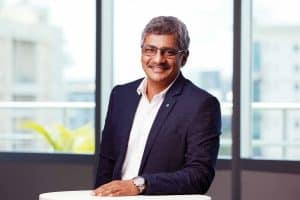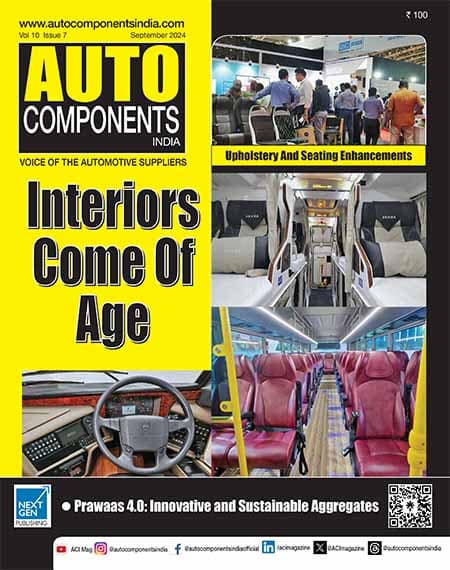In an upfront session, Raghavendra Vaidya, Managing Director and Chief Executive Officer, DTICI speaks to Ashish Bhatia about the innovation centre as the nerve centre for cracking complex problems at Daimler Truck AG, globally.
 Q. What compelled the commissioning of an innovation centre outside Germany when Mercedes Benz Research and Development India (MBRDI) was to an extent looking at trucks? Is it a follow-up to the global separation?
Q. What compelled the commissioning of an innovation centre outside Germany when Mercedes Benz Research and Development India (MBRDI) was to an extent looking at trucks? Is it a follow-up to the global separation?
A. If you look at the Daimler Truck, ambition and strategy globally, we’ve entered into a phase of complete disruption of the automotive industry. More specifically the commercial vehicle industry is led by two things, alternate powertrains and software-led innovation. These are the two things that are going to define the future of commercial vehicles. And since we already had a significant amount of engineering presence in India by way of the earlier setup, which was an engineering centre for all of the dialogue. When it was decided to split the entire Daimler Group into two companies, it was very clear that we needed deep engineering and technical expertise to achieve these ambitions of going towards zero-emission vehicles with either battery or hydrogen-based fuel cells. To lead the industry in software-led innovations. And since we already had this, we decided to up the ante from being an engineering centre to being an innovation centre. India is a perfect place to do that from the perspective of talent, ability and reach that we have globally. So that is why the centre was set up. The other important fact about this innovation centre is, that this is the only innovation centre that works across all the regions of Daimler Trucks like North America, Europe, Asia, and China as well. All the regions and all the brands. So there is a lot of synergy and cross-pollination of ideas that we can establish between regions and between brands. So those are the over arching reasons why we set up this innovation centre in India and Bengaluru.
Q. Would it be fair to say it has now become the backbone of all Daimler Trucks innovations and developments, globally?
A: You’re absolutely right! There is a lot of work. There is a lot of disruption going on, there’s a lot of competition that is popping up everywhere which is not conventional competition that we’ve had. So we’ll have to accelerate the process of innovation, and hence a lot of work which needs deep engineering expertise. And what better place than India to bring all of these things together? So it does become a backbone for innovation and technical excellence on the product engineering side and also to make sure that we drive this innovation across regions and products.
Q. How does it scale up to be the second largest centre? Does it topple the erstwhile second largest centre outside Germany?
A. Yes, it does. It is the second largest engineering centre outside of Germany, and outside of any home location that we have for demo. We have two to three engineering centres across the globe. These are, you know, near-shore centres like we have one centre in Turkey, which is close to Germany, where we leverage the proximity of Turkey and then the language skills. We have a very small centre in Mexico, which is close to North America. But this is the centre that caters to all of the global markets as the only centre covering the entire globe, all the regions and all the branches.
Q. What are the state-of-the-art capabilities that can be expected at the centre?
A. Absolutely. If you look at what we do in DTICI, it’s two things. One is product engineering, other is information technology. So when it comes to product engineering, we have capabilities across the spectrum of how we engineer a commercial vehicle, whether it’s a truck or a bus, starting with mechanical engineering, with electrical, electronics, and engineering, and with a huge focus on both electronics and software. So we cover the entire gamut of engineering capabilities on the product engineering side. And on the IT side, we covered the entire gamut like engineering, after-sales, and manufacturing. And then we have extremely deep expertise in advanced analytics and data science. So the way I would put it is on the product engineering side, we go from sheet metal to software. And on the IT side, we’ve covered most of the domains. We also have very deep expertise in analytics and data science.
Q. If you could share the CapEx earmarked for the centre?
A. This is an engineering centre and all of our capabilities here are digital. So we don’t have test benches; we don’t have a manufacturing facility; we don’t have a prototype shop, which is very physical. So the investment here is really in building capability and people and in skill sets. Most of the work that we do here is digital, except for some of the labs where we have the hardware in loop labs or component test benches for the ECUs. Outside of that, it’s mostly digital. So our biggest investment and our biggest asset are our engineers.
Q. Any exciting projects where work is underway at the centre?
A. On the product engineering side, let me focus on software and electronics and mission vehicles because these are the two areas where we are investing heavily, globally. So under hardware and electronics, all the electronics and software that goes into the truck and the bus, and makes the commercial vehicle intelligent. So we have five domains across software and electronics: HMI which is the head unit that the drivers interact with through connectivity, which is taking all the vehicle data and sending it to the cloud in real time. We have the powertrain which is controlling the engines and making the vehicle intelligent. Through body controls, we make the facilities more intelligent, like, how the tractor and trailer interact with each other. And fifth, and most important is active safety and automation, which is the Advanced Driver Assistance System (ADAS). Out of these, the vehicle connectivity domain is entirely owned and managed by India, which means the entire India team has the global responsibility of driving this. This is huge. I would say a big shift from the regular engineering centres that you find everywhere where engineering work happens but the accountability is still with the headquarters.
We have deep expertise in software development, for example, autonomous driving or ADAS. These are extremely complex, software implementations like the brake can brake by itself, called Active Brake Assist (ABA). It can identify a pedestrian or a bicycle that is going on the side because these trucks are really big and the driver cannot see such blind spots. So there are more sensors and cameras. So in the rest of the four domains, we have deep software development expertise. And there are lots of exciting projects going on in each one of them. So that’s on the vehicle software side.
On the IT side as you can imagine, when a company gets split, we’ll have to reposition and reestablish the digital infrastructure. A lot of the digital infrastructure that we were sharing with the passenger cars is all gone. So we’ll have to set up our own digital infrastructure in engineering and manufacturing, after-sales and so on. So the team are extremely involved in those projects, where we reestablish our digital infrastructure. The second is the advanced analytics and data science that I spoke about, where we are trying to harness the power of data, using machine learning algorithms where we can predict part failures, the part pricing or we can make the factories more efficient by purely harnessing the power of data and using advanced systems.
Q. How will you leverage Karnataka’s manpower and offer upskilling opportunities in line with the Daimler global benchmarks?
A. I don’t think it is any longer a secret that Bengaluru is the melting pot of digital skill sets. Most of the largest engineering centres and digital centres are in Bengaluru. So no question about that. See, what do engineers look forward to when they come to work for Daimler? What they look forward to is working on some of the most sophisticated commercial vehicles. If you look at our trucks and buses in North America and Europe, these are some of the most sophisticated machines with extremely complex engineering, whether it is the powertrain whether it is transmission, whether it is the braking systems or the software and electronics. So they come to work for us to up their skill where they’re working on the best products. This is something that they won’t get anywhere else. Now, that also poses a challenge for us, because this is very complex engineering involved. And Daimler has been around for more than 20 years. We have many complex processes, which have been developed over decades. So we have a two-pronged approach, where we bring in engineers who already have the technical skills like software or electronics, along with a background in automotive engineering. So they know their tradecraft and know how to apply it in automotive engineering. We recruit engineers who come with their tradecraft, whether it is computer science, electrical or electronics, or who have prior work experience in the automotive industry. So they have technical skills, but also the domain skill of how to apply that technology in the automotive industry. We recruit them, and that’s kind of getting there halfway. There is also a Daimler way of doing engineering. So that’s what we scale them up on. Like, how do we do active safety at Daimler? How do we do software at Daimler, and then once we upskill them, then they become part of the team. We also have a campus strategy where we bring very young engineers and interns as Graduate Apprentice Trainees and then we train them on specific skill sets. And then most of them, like really smart kids, get trained on the job. And then over years, they kind of get their tradecraft fine-tuned with an ability to understand the automotive industry. We conduct lateral hiring, and we also do campus hiring. And a combination of them gives us the right skill sets to deliver the solutions.
Q. Which global markets and product mixes will it serve? What are the research, product engineering and IT capabilities that it will bring forth in a seemingly well-established, and proven ecosystem?
A. You are right, it is a seemingly well-defined and well-understood ecosystem, but there is a lot of disruption that’s going on. For example, all the OEMs of commercial vehicles or all other automotive of us have to get to zero emissions. We’ll have to get rid of combustion engines and go to battery electric vehicles, and in commercial vehicles, because of the range requirements, battery electric may not be good enough. So there are a lot of very fundamental engineering problems that need to be solved. Let me give you an example. So we have battery electric trucks, right, which are in production, plying on the roads in Europe and the US. One of the biggest and most complicated problems we’re trying to solve is range prediction. How does the driver know when he or she is going to run out of power? So, range prediction is a very complex problem, nobody has solved it yet and all of us are trying to solve it and whoever is also the first will have a competitive advantage. So, there is a very fundamental problem-solving paradigm we are entering into, because of zero-emission and because of the advances in software and electronics. So these problems are not solved, and they are very complex engineering problems.
There are also scientific problems with battery chemistry or say how to build hydrogen. How do you know, distribute hydrogen, how do you make sure that the compressed hydrogen stays in a certain state? So, we move from where we are to where we will be in eight to 10 years. There are extremely fundamental scientific and engineering problems that need to be solved, right and all the OEMs are in the race of solving them. Whoever solves them and brings them to the market will have a competitive advantage.
Q. Will this have a direct bearing on the export ambitions from the Oragadam plant?
A. We do work with Mercedes Benz as one of our brands. And we do work on some of the engineering problems for foreign brands, whether it is on creating the next derivative or whether it is complying with BSVI or whether it is on connectivity solutions. The challenge here is that the products in each region are very different. What sells in India is very different from what we sell in Europe, what we sell in North America, or what we sell in Indonesia, for example. And our task or our ambition is to make this DTICI the melting pot of all the engineering problems. And we take one solution from one region and one product and try to adapt it to the other product.
Q. Will it be directly accountable for on road performances beyond lab simulated results?
A. So let me answer that question in two parts. One is we have already taken accountability for let’s say, vehicle connectivity. And this is a combination of hardware and software, the hardware is the ECU or the CTP which is a Common Telematics Platform inside the truck, which is continuously collecting data from the truck and streaming it to the cloud. On the cloud, we are running a lot of algorithms and understanding how the truck is behaving. We already have full accountability for that. On the aspect of hardware where one needs to build test benches. The question is are we going to build proto shops? Where we can build a prototype of the trucks? The answer is no, we will not do it. We will stay digital. We will stay focused on solving the problems through digital technologies. We do have limited, hardware capabilities, whether it is hardware in a loop or whether it is test benches for our electronic components, not the mechanic.
Q. Elaborate on the synergies that will be leveraged between the new centre and the existing global innovation centres. Any technology transfers and collaborations that you could speak of?
A. We have engineering centres, in our home locations, like there is an engineering team in Stuttgart, Germany. There is an Indian team in Portland, USA. There is an engineering team in Tokyo. And then there are little hubs. So we work as one team. We don’t duplicate stuff. We don’t solve the same problem in two places. But we try and work as an integrated engineering team, where we harness the capability of that location. For example, Turkey is right next to Germany, they have huge language skills. And there are very large manufacturing plants in Turkey, both for trucks and buses. So we use that as a backbone to build the right manufacturing capabilities. Similarly, Mexico and the other centres. At DTICI, we’re not away from most of the home locations. When we build capabilities here, which are digital, which can be successfully owned and executed, not having to have continuous access to the product or the production facilities, like software, electronics, design and so on. It is how we have structured across the globe.















